Isometric Neck Exercise
Table of Contents
What is an Isometric neck exercise?
- Isometric neck exercise is a good exercise you can do at home when you have neck pain condition pathologies like a slipped disc in the cervical area or cervical spondylosis. The Physical Therapist most commonly prescribed this exercise when a person is suffering from acute pain or the person have not allowed to do resistive neck motions, then this type of exercise is commonly prescribed by the physiotherapist.
- Isometric neck exercises are useful for the action or contraction of the neck muscles or the muscle group.
- While performing isometric neck exercises, the muscle will not change its length or the involved joint does not move.
- Isometric neck exercises assist to maintain the strength or the endurance of the neck muscles. The Physical therapist also prescribed strengthening exercises with isometric neck exercises.
- As the age increases the neck muscles or the ligaments become lesser supplemented. isometric exercise assists to prevent rupture or sprains.
- If you have to cure poor or bad posture, injury of the neck, or degenerative changes of bones, then this exercise will be absolutely helpful to you.
- It will also decrease the risk of future injury to the neck or improve physical endurance.
- In isometric neck exercise, the surrounding joints are not moving only the tension is generated in a particular muscle that we need to strengthen the muscles of the neck.
- This exercise will not lengthen or shorten the muscle which is being exercised.
What is Isometric Exercise?
- Isometric Exercise is placing tension on particular muscles which is exercised without moving the nearby joints. By putting continuous tension on the muscles, isometric exercises will be useful for improving physical endurance or posture by strengthening or stabilizing the muscles.
- There are 2 types of muscle contraction: isotonic and isometric. Isotonic contractions occur when muscles are shorter or longer opposite the resistance, or tension maintains the same. Isometric contractions occur when the tension started increasing but the muscle maintains at a constant length.
- Many strength-building exercises included concentric or eccentric motions, which are both isotonic contractions. Concentric motions cause the muscle to shorten, or eccentric motions lengthen the muscle.
- Isometric exercises will not include the muscles shortening or lengthening. During isometric exercises, the joints are still, or the muscles will not change shape or size. People will typically maintain the isometric contraction for a few seconds or a few mins.
- Some isometric exercises create tension by maintaining the body in a specific position, while others may include holding weights. Maintaining the muscle contraction allowed the muscle tissue to fill with blood or create metabolic stress on the muscle. This can help to improve the strength or the endurance of the muscle.
- An advantage of isometric exercises is that they are normally easy to perform, usually do not require any equipment or instruments to perform an exercise, or it is easily incorporable into numerous weight lifting exercises.
Which muscle involve in isometric neck exercise?
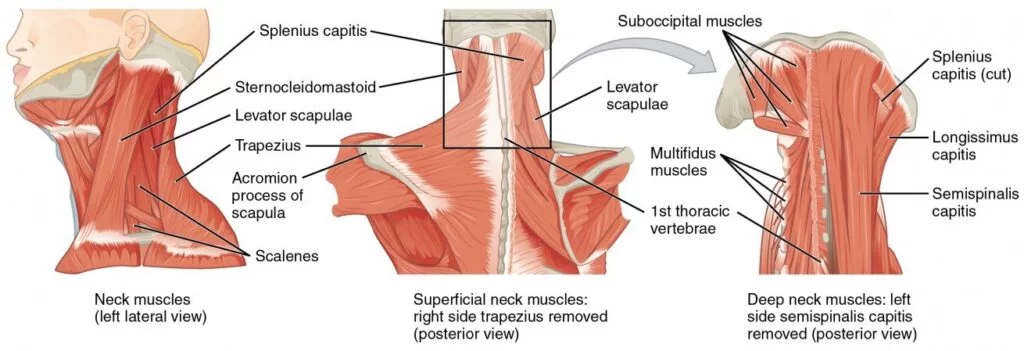
Following are the neck muscles used during isometric neck exercises.
| Neck Muscles | Action | Nerve Supply |
| Sternocleidomastoid Muscle | Extension and | |
| rotation of the neck, | C2, C3 | |
| flexion of vertebral column | ||
| Scalenus Muscle | Flexion and rotation of neck& | Lower cervical |
| side flexion | ||
| Spinalis Cervicis Muscle | Extension and rotation of the neck | Middle or lower cervical |
| Spinalis Capitus Muscle | Extension and rotation of the neck | Middle or lower cervical |
Health benefits of doing isometric neck exercises
- Help to decrease the pain in the whiplash injuries of the neck.
- Helps to decrease the severity of chronic upper back pain.
- The doctor may suggest you to performing some of these exercises after a motor vehicle accident or an upper back injury.
- Helps to ease the tension in the neck.
- Helps to decrease tightness or stiffness. They can decrease the pain or help to increase flexibility
- Help to prevent neck or cervical spine injuries also easy to perform an isometric neck exercise.
- Beneficial exercises for activating muscle fibers at 1 time.
- Effective exercise for lowering blood pressure.
- Beneficial in Cervical spondylosis, Cervical radiculopathy conditions.
- Maintain Muscle property, function, and strength.
The isometric neck exercise
The isometric neck exercise that you can do while sitting, standing, or lying on your back:
Isometric neck exercise in standing position:
- For this exercise, you require a medium size ball or you have to stand nearer to the wall side.
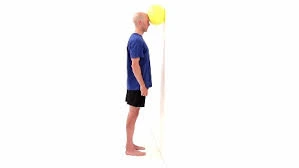
Neck flexion
- You have to stand straight with an erect posture, while the forehead is resting on a ball against the wall. By the forehead, you have to smoothly press the ball nearer to the wall.
- Maintain this position for 5 to 10 secs.
- The back should be straight or extended during the whole exercise.
Neck extension
- You have to stand straight with an erect or upright posture, with the back of the head resting on a ball opposite the wall. By the head, you have to smoothly press the ball nearer to the wall.
- Maintain this position for 5 to 10 secs.
- The back should be in an upright position during the whole movement.
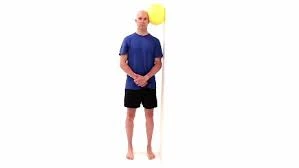
Neck Side flexion
- You have to stand straight with an erect or upright posture, with the left side of the headrest on a ball opposite the wall.
- Slowly press the ball by the left side of the head nearer the wall.
- Maintain this position for 5 to 10 secs.
- The back should be in an upright position during the whole movement. Repeat this on another side also.
Isometric neck exercise in the Sitting position:
- In a sitting position for neck isometric exercise, you will need either a chair or a table. while you have to sit with an erect posture in a chair. In this position, you will do all neck motions which are explained under, or if you want to do this exercise in standing then you have to stand with the hip or the shoulder-width apart with the torso extended.
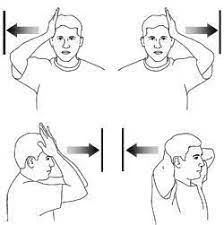
Neck flexion
- Put the hand on the forehead then slightly push the neck in a forward direction, the hand remains in the same position you give light pressure opposite the movements like pushing the beside.
- Hold this for 5 to 10 secs.
- The back should be in an upright position during the whole movement.
Neck extension
- Put the hand on the back of the head then gently push the neck in the backward direction, the hand should be in the same position, just give little pressure opposite the movements like pushing to the forward side.
- Hold this for 5 to 10 secs.
- The back should be in an upright position during the whole movement.
Neck Side flexion
- Put the hand left side of the head with the head straight or the chin in a neutral position, now bring the head towards the left side shoulder by gently pushing the hand by the head.
- Hold this for 5 to 10 secs.
- The back should be in an upright position during the whole movement.
- Repeat this for right-side neck flexion.
Neck Rotation
- Put the right hand on the left side of the chin or turn the head slightly nearer the left side by gently pushing the hand and trying to look back at you.
- The back should be in an upright position during the whole movement.
- Hold this for 5 to 10 secs.
- Perform this exercise on the right side by taking assistance from the left hand.
Isometric neck exercise in Supine lying position:
- For this exercise, you have to lie down on the back over a plinth or the mattress by using a small pillow or a rolled towel below the head, the hand by the side.
Neck flexion
- For this exercise, you have to lie on the tummy pillow used under the head you have to push the pillow by the forehead or hold it for 5 to 10 secs.
Neck extension
- For this exercise, you have to lie down on the back over a plinth or a mattress by using a small pillow or a rolled towel below the head, the hand by the side.
- Push the pillow by the back of the head, or hold this for 5 to 10 secs.
Neck side flexion
- For this exercise, you have to lie on any side right or left side.
- Take a pillow below the head, now gently push the pillow by you nearer to the plinth.
- Hold this for 5 to 10 secs.
- Perform this on the right side.
Isometric neck exercises video
When you should not do this exercise?
- If a person feels any pain or discomfort while performing an exercise.
- If you had any neck injury occur in a previous short period of time.
- If the doctor advised you for resting.
- If you had any head injury.
- If the symptoms worsen after doing a neck isometric exercise
- If you have high blood pressure, or you may have difficulty holding a breath.
Avoid these mistakes while performing isometric neck exercises:
- Do not move the shoulder or the trunk while doing an exercise.
- Do not give too much pressure on the head.
- Keep straight the neck while doing this exercise.
- Do not contract the muscle.
- Maintain the proper alignment of the neck while doing a neck isometric exercise.

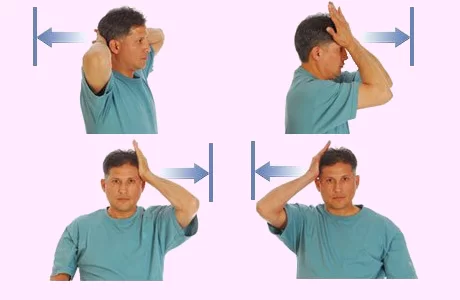
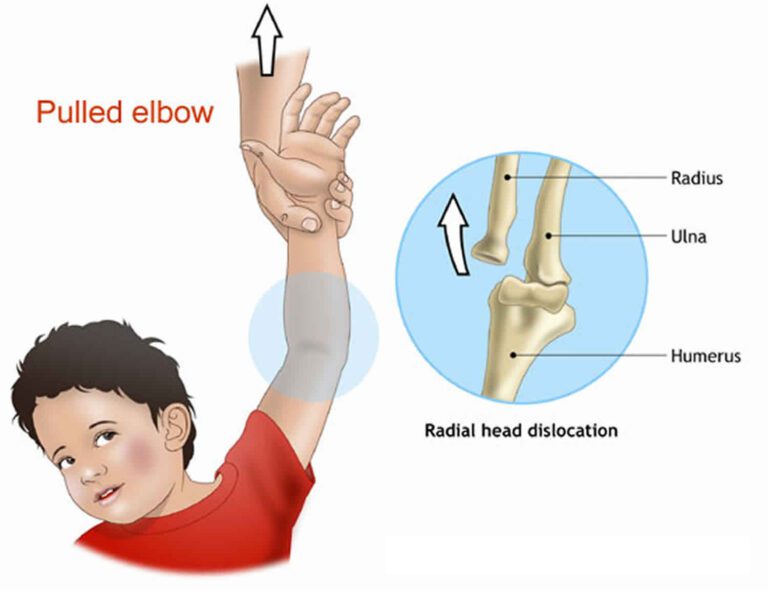


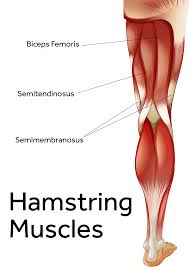
2 Comments